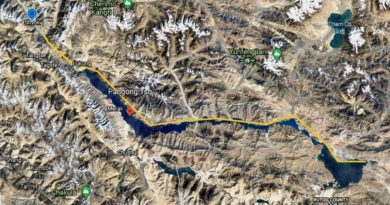Supreme Court’s Green Directive: Himachal on Notice over Ecological Distress.
( By Yashvardhan Singh, Advocate Supreme Court of India)
In a major development concerning the state, the Supreme Court on Monday, issued notice to the state’s Chief Secretary asking him to file the state’s response regarding several ecological emergencies affecting Himachal.
THE CONTEXT
The Supreme Court passed these directions while hearing a Special Leave Petition concerning the validity of a Notification dated 6.6.2025, issued by the Town and Country Planning Department, Govt. of Himachal Pradesh. The Special Leave Petition was filed at the instance of M/s. Pristine Hotels & Resorts Pvt. Ltd.
The impugned notification provided for an amendment to the Development Plan for Shimla. The Amendment contemplated that, ‘Shri Tara Mata Hill Green Area’, be regarded as a ‘Green Area’ in terms of Regulation 17.2 of the Development Plan. The effect of the notification was that in Shri Tara Mata Hill Area, no new private construction would be permissible.
Pristine Hotels was aggrieved by the Notification as it could no longer develop a hotel or resort in the said area. A writ petition filed by Pristine Hotels under Article 226 was rejected by the High Court’s on 2nd July, 2025. The High Court returned the finding that Pristine Hotels could not be regarded as a ‘person aggrieved’ and that it had no locus to challenge the notification. The High Court observed that Pristine Hotels had no permission to buy land in the state in terms of Section 118 of the HP Tenancy and Land Reforms Act and being a resident of Chandigarh, it had no interest in the State of HP. The High Court concluded that the Petitioner has suffered no legal injury and dismissed the writ.
In appeal filed under Article 136 of the Constitution, the Supreme Court refused to interfere. However, besides the lis related to the Notification, the Supreme Court deemed it appropriate to issue broad directions in context of the ecological imbalance, recurrent landslides, and damage to life and property in the state. In this regard, the Supreme Court directed its Registry to register a writ petition in public interest and take appropriate directions from the Chief Justice of India. This power of the court to institute such proceedings can be traced to Order 38, Rule 12(1)[a] of the Supreme Court Rules, 2013. Under this the Supreme Court, may commence a public interest litigation petition under Article 32 of the Constitution, suo motu.
THE OBSERVATIONS
In its order the Supreme Court highlighted several issues affecting the State’s environment. The court underscored problems caused by the state’s relentless and inadequately planned tunnel and road construction projects. It highlighted that hill slopes are being cut unscientifically without adequate stabilization measures. The court also took notice of the devastation the state suffered in the monsoon season of 2023 and 2025.
The court pointed out instances of recurring floods, landslides and destruction of life and property. The unregulated hydropower development (dams, tunnels, blasting) destabilising slopes, altering river flows and devastation of aquatic life. The court pointed out how four-lane road and tunnel construction ought to be carried out based on local knowledge and expert geological input. The court specifically noted that the Satluj river has been reduced to a rivulet and that the Bara Shighri glacier in Lahaul Spiti has receded by 2 to 2.5 kilometres.
In addition the court noticed that uncontrolled tourism growth has strained the natural environment and compounded problems of traffic congestion, waste management, noise pollution, and overuse of water resources. Lastly, in context of unregulated mining, the court held that such activities are impacting structural integrity of neighbouring roads.
The court while making these observation recorded the Advocate General’s concession that the state has failed to pay attention to the ecological problems affecting Himachal.
Granting a time of four weeks- the court directed the State of Himachal Pradesh, as well as the Principal Secretary, Ministry of Environment and Forests, Govt. of India- to file their responses. The court has listed the matter for 25th August and directed the State of HP to submit an appropriate report in this regard.
CONCLUSION
The Supreme Court’s intervention is timely. Today, Himachal is grappling with the twin challenges of ecological disasters and a struggling economy. Through its proactive approach the court has sought to impose necessary checks on growth and expansion of the state economy. It has cautioned how building of roads, tunnels, multi-storey structures and tourism infrastructure may affect the state in an irreversible manner. These suo motu proceedings may serve as a crucial forum to balance economic development and ecological preservation. Himachal Pradesh and its people have undeniable economic needs. The Supreme Court has stepped in to remind them about ecological imperatives.



